The ability to prove to a bank that you deserve a loan for the purchase of new space for your ever-growing practice is a real pain in the neckthat is, unless you take on a tenant who specializes in pains in the neck. Just ask optometrist Kevin Anderson, of Fort Collins, Colo.
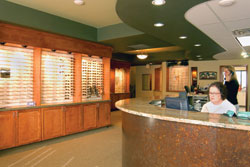 |
|
The first floor of the Ft. Collins, Colo., condominium-style building that Dr. and Mrs. Anderson share is 3,050 square-feet. |
Dr. Anderson decided to focus more on disease-based eye care and recruit optometry-friendly ophthalmologists because a nearby ophthalmology practice, to which he referred several patients for LASIK and other procedures often did not refer patients back to him. He also wanted to provide a non-competitive referral center to his nearby colleagues who had the same experiences as he did with certain ophthalmologists.
The two ophthalmologistsone a glaucoma specialist, the other a corneal/cataract specialistused Dr. Andersons 1,200-square-foot office space twice a month, while Dr. Anderson saw patients at the other practice he rents, located 75 miles away in Aurora, Colo.
Suddenly, the Ft. Collins practices optical/reception room, one exam room and one assessment room werent big enough to handle all of the new patients that the new disease-based equipment and ophthalmologists had garnered. Now, patients and staff members were bumping into one another. The last straw: My patients were performing the OCT test in the optical area, with towels over their heads to block the light coming through the windows, Dr. Anderson says. These patients were still getting great care, but the delivery of the test was not real professional. I knew it was time to find a bigger space.
During a drive, in October 2002, Dr. Anderson and his wife Susan spotted a sign stating that pre-approved condominium-style buildings were being constructed in Fort Collins. The buildings were two stories and contained four individual suitestwo per floorthat took up 3,050 square feet. The stipulation: entire floors (half a building) had to be purchased to begin the construction of a building.
Because of the speed at which Dr. Andersons practice was growing, he knew that his practice could use one suite and eventually pour into the second suite. Also, the location was perfect, as he did not want his new practice to be too far from his current Fort Collins practice. There was one building that was finished. The rest of the lots were empty, Dr. Anderson says. My wife and I toured the finished building, and in particular a suite that was designed for a periodontist. Inspired by the way the gum-disease specialist transformed the suite into a professional medical office, Dr. Anderson decided to buy half-a-building. But, doing so was easier said than done.
Loan Groan
Two banks told Dr. Anderson that he did not have the cash flow required to qualify for the loan amount needed to purchase half a building. I didnt have a large enough down payment, so I refinanced my house, restructured all of my debt in a 12 to 14-month period and then paid off every single bill I had, he says. When I went back to one of the banks, I was told that what I had done still wasnt enough to secure the loan I needed.
At the time, Susan Anderson had been out of massage therapy school for a year (she holds a medical massage practitioner license) and established a profitable home massage therapy business. One night, my wife and I went out to dinner, and we started talking about sharing space, Dr. Anderson says. There were security issues with having a home business, and I knew I wouldnt be using the buildings other suite for a couple of years. Also, having another tenantaside from the ophthalmologistswould put me over the threshold for what I needed to convince a bank that I could support the cost of the building.
Finally, the couple felt that joining forces could create cross-promotional opportunitiesespecially if their individual services were somehow linked. I decided to expand my massage therapy business into a full-fledged spa because the suite my business would be housed in exceeded the amount of space needed for a massage therapy business alone, and the spa could offer the eye-related service of an esthetician [one who gives facials and specializes in overall skin care], says Mrs. Anderson.
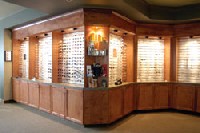 |
| Clients of Mrs. Anderson have been known to purchase sunglasses from Dr. Andersons large dispensary. |
At the suggestion of his accountant, Dr. Anderson approached a new, small local bank with his new plan. This bank wanted to build a presence in the community, so they were interested in hearing me out. I explained to the bank officer that my practice had grown faster than ever before with the addition of the ophthalmologists and disease-based equipment and how I expected even larger growth with the addition of my wifes business, Dr. Anderson says. Then, I told her [the bank officer] that I wanted to use a Small Business Association (SBA) loan because of its fixed interest rate, lack of additional fees to refinance and lack of balloon payments. The officer then instructed Dr. Ander-son and his wife to fill out SBA forms and to write up their business plans.
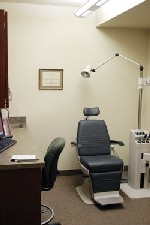 |
| Dr. Andersons three exam rooms at his new practice allow both him and his staff to meet the needs of his continuously growing patient load. |
After the Andersons accountant testified that the couples financial statements were accurate, the bank and the SBA agreed to loan Dr. Anderson the money he needed. I put down 10%, the SBA offered 40%, and the bank provided 50%, Dr. Anderson says.
The End Result
In late July 2004, Village Optical and the Fort Collins Medi-Spa opened its doors. The front door of the building is labeled with Dr. Andersons name, the names of the ophthalmologists and the Fort Collins Medi-Spa.
A small, half-moon waterfall, seated atop a large granite reception desk greets everyone. The waterfall is there to let the Medi-Spas clients know they are in the right place, as the reception area features a large optical dispensary and leads into Dr. Andersons practice first. The new practice features an edging lab, accessory testing room, three exam rooms and an employee kitchen.
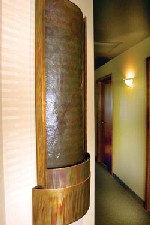 |
|
The sound of the trickling water from the Medi-Spas large wall-mounted copper waterfall instills a feeling of calmness, says Mrs. Anderson. |
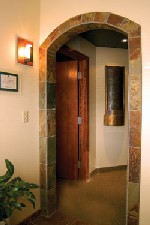 |
|
This slate archway in the Medi-Spa was designed to convey relaxation via its warm earth tones, says Mrs. Anderson. |
Many first-time clients who come in for a spa service say, I didnt know there was an eye doctor here, and they end up scheduling an eye exam. Some even pur- chase sunglasses from my husbands optical shop, Mrs. Anderson says. I think that this happens because in order to get to the spa, they have to walk through my husbands practice, and this exposure makes them think of their eye health.
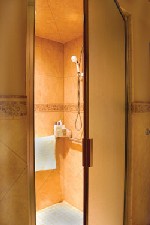 |
|
After a mud wrap or salt glow (the use of natural mineral salts and aromatic oils to exfoliate the skin and stimulate circulation), patients can take a relaxing shower in the hydrotherapy room. |
Since the Village Optical and the Fort Collins Medi-Spa opened its doors, Dr. Anderson says he is seeing more new patients than existing ones. In looking at a 12-month period from August 2004 to August 2005, the practices gross revenue is up 28%, Dr. Anderson says. Because of this growth, he is currently looking into adding on another exam room and a testing room. He is also interested in taking on a partner to share the workload. The growth has been won- derful, but Im starting to get burned out, he says.
Sounds like Dr. Anderson could use a massage.
In Practice Profiles Part 3, which will appear in the December issue, we talk to an optometrist who learned to speak Spanish to be more accessible to the population of his Delaware community.

